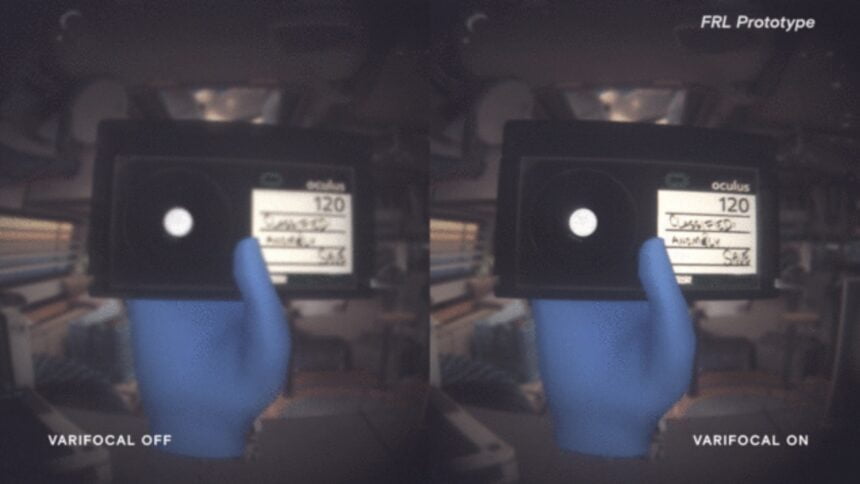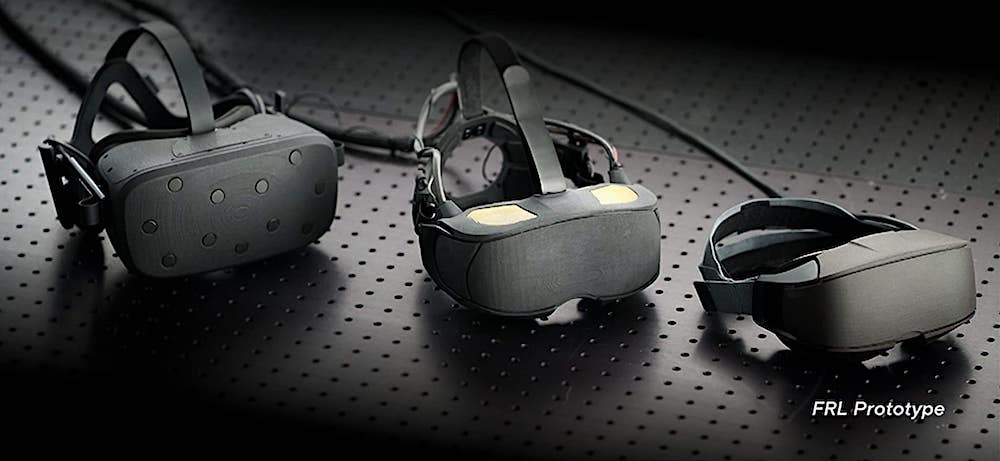Could Meta’s New Cambria Support Variable Focus?
Project Cambria is Meta’s new next-generation virtual reality headset set to launch in Q2 this year. Could it support variable focus?
A killer feature that many virtual reality headsets have been missing and which could have a huge bearing on the user experience is variable focus. This is the ability of the lens to blur out peripheral vision and focus on one object. Currently, virtual reality headsets display all the images with the same resolution which results in a vergence-accommodation conflict (VAC).
The VAC occurs when a stereoscopic image pair takes the vergence state of our natural visual system to arbitrary distances while the accommodation or focusing state of our eyes is driven, optically, towards a fixed distance. The vergence-accommodation conflict causes various kinds of visual discomforts during virtual reality experiences such as eye strains or headaches, particularly when a user spends an extended amount of time in VR, AR, or MR sessions. It also degrades your visual experience of the immersive event.
Virtual reality hardware developers have been thinking about this problem and have been researching various ways to resolve it such as the pancake optics.
Meta researchers have also been working on this problem for quite some time now. A Meta team even claims to have solved this problem after several years of research although the variable focus technology is yet to find its way into commercial VR hardware devices.
Why is variable focus so important for the future of VR headsets? What does it bring? Could Cambria headset support this killer feature?
What is the Vergence Accommodation Conflict (VAC)?
When your eyes are focusing on a physical object in close proximity such as a raised finger, the object you are focusing on becomes sharply defined while the background is blurred and vice versa. This natural variable focusing is the natural physics in the human eye that allows us to see objects in focus clearly and blurs out those in the periphery that our eyes aren’t focusing on.
However, this natural focusing is not realizable in virtual reality headsets because, in virtual reality, the whole image is displayed evenly in focus. Our eyes and brains are not familiar with this unnatural visual system in VR and as a result, it irritates the visual system and can cause eye pain, headaches, nausea, or blurry vision.
This phenomenon is referred to as the vergence-accommodation conflict (VAC). If the VAC can be resolved, we would have a more natural visual experience in virtual reality and this would be a major VR breakthrough as the experiences will appear more natural and realistic just as we experience them in real-life. The resolution of the vergence-accommodation conflict will also allow users to spend more time in virtual reality as it will be less stressful to the eye.
How Does the Vergence-Accommodation Conflict Occur?
When you are looking at a physical object, there are two processes involved. On the one hand, your eyeballs will adjust to the object through a gentle rotation known as vergence. On the other hand, the lenses in your eyes are organically shaped through a muscle contraction such that the object you are looking at appears sharp, a process known as accommodation.
In natural vision, these optical mechanisms work concurrently. However, with a virtual reality headset, a conflict occurs in these optical mechanisms because the VR headset has just one focal plane that is fixed at a distance of approximately 2 meters. As a result, everything you see, including the object and the background, appears equally sharp and seems as if it is two or more meters away irrespective of the actual distance.
As a result, when you are looking at a virtual object that is less than 2 meters away, your eyes or visual system will receive contradicting information. Your eyes will rotate as if they have been directed at an object that is 2 or more meters away. However, the lenses will simultaneously attempt to locate an object in the immediate vicinity.
The sensory discrepancy created has some consequences as far as your immersive experience is concerned. For instance, your eyes will tire out more quickly, you might get a headache or your vision gets blurred. You may also experience a feeling of nausea. Because you are frequently interacting with numerous objects in very close proximity in a virtual reality environment, your visual system will be grappling with the vergence-accommodation conflict all the time.
To resolve the VAC problem, the eye must be ‘fooled’ into believing that it is actually looking at an object that is in front of it rather than one that is 2 or more meters away.
This is realized through a variable focus or artificial focus shifting that involves simulating focusing through a blurring effect.
Meta is Building VR Prototypes with Variable Focus
Meta has developed various prototypes that support variable focus under the code name Half Dome. The Meta Half Dome prototypes use a varifocal display that tracks the eyes and the variable focus is changed to correspond with the vergence of the eye.
Half Dome 1 was presented in May 2018 while Half Dome 2 and 3 were presented in September 2019.

In Half Dome 3, Meta engineers managed to replace the complex mechanics of the two predecessors (Half Dome 1 and Half Dome 2) with immobile components thereby miniaturizing the technology. In the prototype, liquid crystal lenses are connected in a series and the focus shift is effected purely electrically rather than through mechanical parts. In the video below, you can see the changing sharpness of the foreground and the background depending on the active lenses.
To learn more about the variable focus technology in Meta’s Half Dome prototypes, watch this video lecture by Meta lead display researcher Douglas Lanman. In early 2020, Lanman stated that Half Dome was almost ready for the spotlight.

That is interesting as Meta’s research was maturing just as the company was working on a new high-end VR headset that will, among other things, be used to test out its cutting-edge technologies and innovations. So, could we see the variable focus technology being added in Meta’s upcoming VR headset codenamed Project Cambria?
Will Project Cambria Feature Variable Focus?
Because virtual reality headsets need to ‘know’ where the wearer is looking, variable focus (artificial focus adjustment) will require eye tracking in the VR headset. Project Cambria supports eye tracking so that’s already a promising step.

It isn’t clear whether the Meta headset has installed liquid crystal lenses similar to the Half Dome 3.
However, in a blog post, display expert Karl Guttag talks about finding Meta patents that describe a combination of pancake lenses and liquid crystal lenses. The drawings in the patent are also reminiscent of a similar graphic shown during the Project Cambria official announcement in late 2021.
However, if you take a closer look at the drawings, it is quite apparent that the middle element, the liquid crystal lenses, is missing in both the graphics and the subsequent rendering. Watch the video at 1:05:00.
We Aren’t There Yet with Variable Focus
The technology that will replicate the natural eye focus in our visual systems in virtual reality hasn’t matured yet.
Meta Cambria will be one of the first virtual reality headsets that will implement pancake lenses. Patents discovered so far also suggest that Meta is currently undertaking research work on a combination of pancake lenses and liquid crystal lenses.
Head of Reality Labs at Meta Andrew Bosworth has also made statements to the effect that Half Dome 3 will not materialize anytime soon because it is difficult to implement in terms of fragility, cost, and weight and that the company had not yet figured out a way to balance these factors, confirming that Meta is still working on the technology.
It is possible the liquid crystal lenses would be in Cambria or Meta may have additional surprises in store for its high-end next-gen VR headset.
At the moment, there still isn’t enough information on Project Cambria in spite of the many leaks but we can expect additional details on the VR-AR headset to stream in the course of 2022 before the summer launch.
https://virtualrealitytimes.com/2022/01/09/could-metas-new-cambria-support-variable-focus/https://virtualrealitytimes.com/wp-content/uploads/2022/01/The-Half-Dome-Prototypes-600x277.jpghttps://virtualrealitytimes.com/wp-content/uploads/2022/01/The-Half-Dome-Prototypes-150x90.jpgTechnologyTechnology DiscussionProject Cambria is Meta’s new next-generation virtual reality headset set to launch in Q2 this year. Could it support variable focus? A killer feature that many virtual reality headsets have been missing and which could have a huge bearing on the user experience is variable focus. This is the ability...Sam OchanjiSam Ochanji[email protected]EditorVirtual Reality Times - Metaverse & VR
